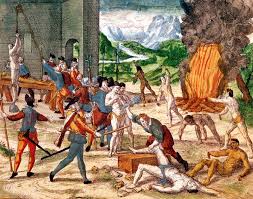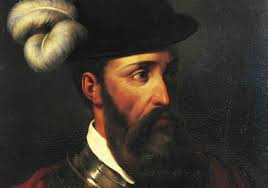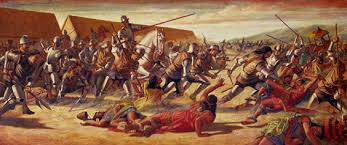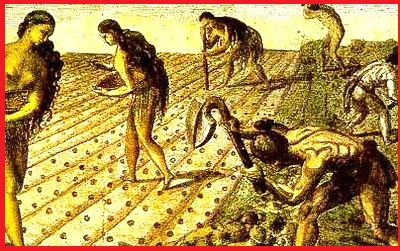What was the Encomienda System?
Contents
The Encomienda system is a Feudal law designed by the Spanish conquistadors or conquerors to establish governance and control over the newly conquered territories of the native Indians. Encomienda was derived from the Spanish word “encomendar” or to entrust.

The encomienda system was a system used by the Spanish to control and exploit indigenous populations in their colonies. The system gave Spanish colonists the right to demand labor or tribute from the indigenous people in their area, and often resulted in abuse and mistreatment of the indigenous people. The system began in the early 1500s, and ended around the early 1600s.
The purpose of the encomienda system was to provide labor for the Spanish colonists. The colonists would often demand labor from the indigenous people in order to build roads, bridges, and other infrastructure projects.
The indigenous people were also forced to work in the mines and on plantations. The encomienda system often resulted in the abuse and mistreatment of the indigenous people.
The Spanish colonists would often demand more labor than the indigenous people could provide, and would often punish them if they did not meet their demands. The system also resulted in the loss of cultural identity for the indigenous people, as they were often forced to abandon their traditional way of life.
By the end of the 15th Century, Spain had conquered major parts of the North, South, and Central America as well as the Caribbean. The Spanish conquistadors defeated the Incas in 1572 under the efficient leadership of Francisco Pizarro.

The Crown now wanted to rule over the natives and own their lands and control them in every possible way. So, they decided to enforce the Encomienda System and entrusted their royal Spanish lords and elites to create a new world and to develop a civilized nation in their own terms.
The Beginning of the Encomienda System
The Encomienda System was first handed out by Christopher Columbus who conquered West Indies at the end of 15th Century. It started in the capital city of the Inca Empire, Peru.
Columbus granted his subordinates encomiendas and awarded them for their devotion and service towards the country. The same power was vested upon higher officials and priests who were given land and control.
The encomenderos (people who practiced encomiendas) not only owned these lands, but also the families or communities that lived there.

The natives were ordered to pay taxes, tributes in kind of gold, silver, crops, poultry, labour, and foodstuff to the grantees. In return, the encomenderos promised to protect them, take care of their wellbeing, provide education and also convert them into Christianity. The natives were even made to work as labourers in their own fields.
Encomienda System: The Purpose
One of the main purposes of the Encomienda System was to convert the natives into Christianity. The Spaniards not only wanted to invade their lands and wealth but also to educate and civilize them and include them in their own culture and society. Natives who observe the Roman Catholic faith will be treated as subjects of the Crown and will get protection.
Just after the war, the soldiers were fatigued and in no condition to work. The Crown rewarded them with land, wealth and power to earn their trust and loyalty. The natives were used instead as laborers and provided service to the crown.

There was a dual purpose behind the Encomienda System. The Spanish rulers not only wanted to rule the natives but also wanted to control the conquistadors so that they don’t revolt against the crown and this was only possible through this system.
How did the Encomienda System work?
There was a thin line between the Encomienda System and outright slavery. Though the Spanish rulers did not want to enslave the natives, it eventually led to a feudal system where they were subjected to cruelty and had little choice of their own.
In the beginning, the natives learned the Spanish language and also earned wages for their labour, but in the end, the system grew corrupt and violent.
The encomenderos were not only required to collect taxes from the natives but also had to pay their share of tax to the Crown. There were certain restrictions to the grant. The grant was only valid for two generations and the officers could be transferred to any region any time. The encomenderos became greedy and in order to earn more profits started to abuse and torture the natives.

The natives were made to work under inhuman conditions. Excessive demand on cattle and crops were made which were sometimes impossible to fulfill. Sometimes, the encomenderos would appoint middlemen for collecting taxes from the natives who would again ask for their share which created misuse of the system itself.
The encomenderos were protected by law and were not allowed to visit the places where the natives lived. So, the natives have to travel great distances in order to bring their crops and tributes to the officers, which was tiresome and expensive.
If there was any sign of revolt among the natives, strict action was taken against them and they were even hanged.

The end of the Encomienda System
Finally, in 1542, new laws were passed by Charles V of Spain, who put an end to the system. The natives will now be treated as citizens of Spain and cannot be forced to work. No new encomiendas were to be granted and measures were taken against those who tried to practice it.
The encomienda system began to decline in the early 1600s, as the Spanish government began to realize that it was unfair and exploitative. The system was officially abolished in 1650. However, the effects of the system continued to be felt by the indigenous people for many years afterward.
